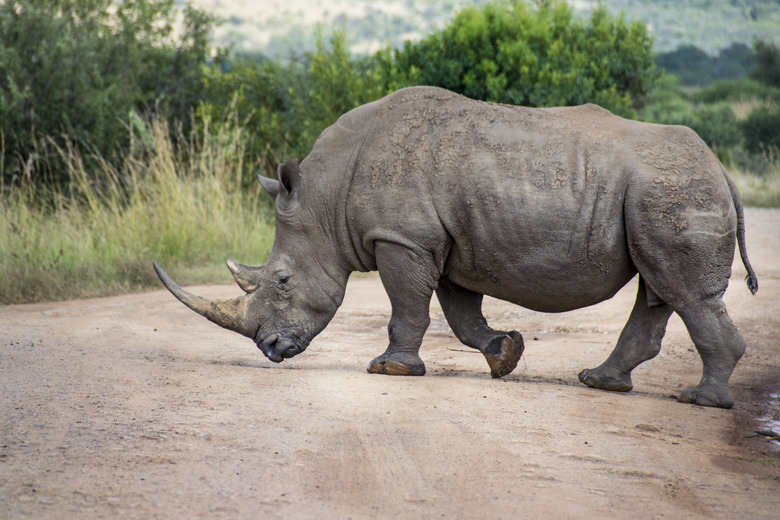How To Conserve Plants And Animals
Human efforts to conserve plants and animals mainly focus on two strategies: conserving the environments they need, so that they may thrive; and avoiding the killing of the plants and animals themselves. The point of conservation aims to ensure future resources. However, financial opportunity often drives humans to alter environments and harvest species of plants and animals, sometimes to the point of extinction. The nature of economics conflicts with conservation at times. Because increasing the scarcity of a resource makes it more valuable to those who can still get it, incentives rise as resources dwindle.
Conserve the Environments for Plants and Animals
Conserve the Environments for Plants and Animals
While humans demand plants and animals as resources, sometimes it's their environment that holds value. Africa provides examples of forest land lost to agriculture, resulting in a loss of biodiversity. Agriculture and aquaculture replace coastal mangroves around the world, and urbanization, too, destroys the natural habitat of many species. The Philippines lost approximately half of its mangroves to aquaculture between 1968 and 1983. Conserving these environments through sustainable intensification of farming and regulations to protect remaining wild areas from development would conserve the biodiversity within them. Some efforts exist to improve these areas, but they require more work.
Control Market Forces for Plant and Animal Resources
Control Market Forces for Plant and Animal Resources
African elephant and rhino ivory offer an example of depleting animal resources: as these species fall prey to ivory poachers, their tusks and horns grow increasingly rare and, thus, more valuable. Buyers hoard ivory, hoping for higher value in the future. Prices for Asian tropical hardwoods like rosewood have risen as much as 90 percent in just the last year. In each case, conserving the plant and animal resources requires fighting market forces, such as placing a ban on ivory sales and restrictions on logging exports.
Reduce Human Demand on Animals and Plants
Reduce Human Demand on Animals and Plants
Rising standards of living in developing countries drives demand for meat production, as more people can afford to eat meat. This raises demands on natural resources to produce meat. For example, the United States could feed 800 million people with the grains it uses to feed its livestock. As a product of that, humans destroy more natural ecosystems to accommodate the demand for meat. Choosing to eat less meat in one's diet would reduce the demands on all of the required resources, from food to water to space, used to produce it.
Consider How Solutions May Cause Unintended Consequences
Consider How Solutions May Cause Unintended Consequences
Sometimes, a good idea brings unintended consequences in the complexity of Earth's natural environment. Hydroelectric dams generate electricity from the energy of flowing water — by itself, that sounds good, since it reduces the use of fossil fuels. But dams also block fish migration routes. Wind turbines generate electricity without pollution, but there's considerable debate about how many birds they kill. A century of policies to extinguish forest fires in the western United States led to forests full of fuel, and massive fires as a result. Each example shows how manipulating the environment can involve a trade-off between benefits and harm to plants and animals.
References
- Newsweek: The Economics of Extinction: Africa's Elephants and Rhinos in Danger
- Smithsonian.com: How Many Birds Do Wind Turbines Really Kill?
- International Union for the Conservation of Nature: Mass mangrove restoration: Driven by good intentions but offering limited results
- International Fund for Animal Welfare: Ending the ivory trade
- Yale Environment: The Case Against a Legal Ivory Trade: It Will Lead to More Killing of Elephants
- Cornell Chronicle:U.S. could feed 800 million people with grain that livestock eat, Cornell ecologist advises animal scientists
- United Nations Food and Agriculture Organization: Dams and Fish Migration
Cite This Article
MLA
Silbajoris, Alex. "How To Conserve Plants And Animals" sciencing.com, https://www.sciencing.com/conserve-plants-animals-6080418/. 23 April 2018.
APA
Silbajoris, Alex. (2018, April 23). How To Conserve Plants And Animals. sciencing.com. Retrieved from https://www.sciencing.com/conserve-plants-animals-6080418/
Chicago
Silbajoris, Alex. How To Conserve Plants And Animals last modified August 30, 2022. https://www.sciencing.com/conserve-plants-animals-6080418/
